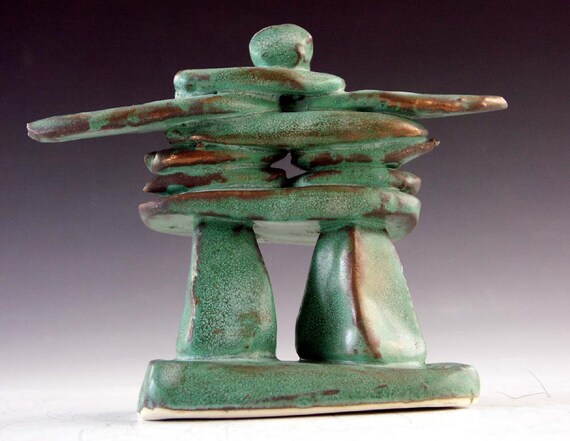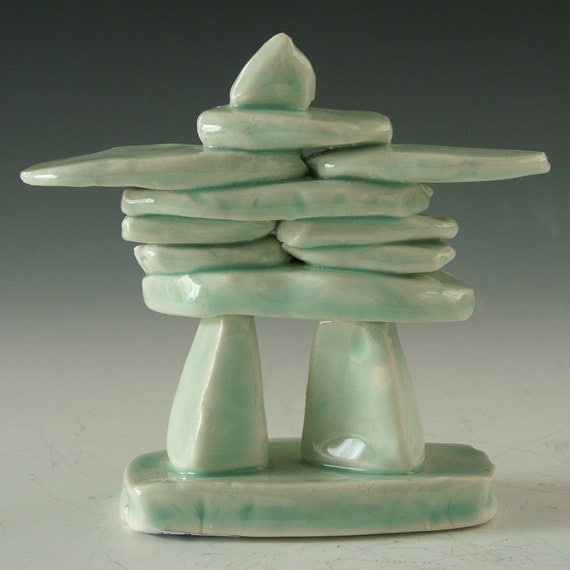I was just looking at a great treasury this morning. I felt honoured to be one of the featured artists. The sculpture that was shown was one of my Inukshuks. I really enjoy making these objects because they bring back some great memories.
 |
| Inukshuk |
 |
| View from the Airstrip in Alert. 1971 |
I was fortunate to have had the opportunity to work with some of the young Inuit men who Who were raised in the northern regions of Canada. Their village was far to the south of our station. In effect, they had to go to Ottawa for their interviews and then fly north to alert in a C130 military aircraft, along with the regular military service members, who were on their way north.
 |
| The Aircraft on the Thule Greenland Airstrip. We spent an evening before the last leg of our journey to Alert. |
Alert has a polar climate. The summer months are marked by 24 hours of daylight, with the winter giving us 24 hours of darkness. I was lucky in that I had two months of daylight, two months, day and night, and then the last two months of my duty was in darkness.
 |
| Setting up the ice fishing hut. The fish was Arctic Salmon |
 |
| We had a radio station that helped fill our hours with music. |
We came across a large pile of stones that was man made. Nestled in amongst the pile of rocks was a covered tin can. When we opened the container, we found scraps of paper with notes, written by those who had passed by the spot before us. The comments were just small statements, giving the names and dates and small editorials. Some logs talked of the weather and the sentiments of the writer.
 |
| During the summer days hiking was the main activity when we were off duty. |
Charlie, who was Inuit, walked around the stones, studying the form and the methods of construction. I asked him what he was doing. His response was that he was trying to feel the spirit of the original builders of the cairn. I saw that he was treating the site with reverence. The pile of stones seemed very important to him. When we stopped to eat our sandwich, he explained what these markers meant to his people.
 |
| Charlie was one of the heavy equipment operator. |
Charlie went on to explain that the inuksuk means existence of the northern peoples. It marks a spot where an Inuit family may have rested or camped.
 |
| One of my favorite colours--the copper celedon. This Inukshuk is available from my shop. http://www.etsy.com/listing/78346621/inukshuk-sculpture-art-of-the-inu-inuit |
It may have been built in the form of man with one arm longer that the other. The longer arm was to point the way of the traveler. Much the same way the southern natives would mark stones, cliffs or trees with petroglyphs.
The inuksuk was often built on high ground that gave it maximum visibility. The far north has no trees to help with the perspective, so distance can be confusing. The inuksuk allowed distance to be measured in comparison to the height of a man.
 |
| Distance was difficult to gauge. We walked for hours but the sun did not go down. |
Many inuksuk were simple piles of rocks that were set up to protect the hunter from the cold winds, or to act as a blind, and allow him to ambush passing game. The more elaborate inuksuk would have a set number of stones to make the man figure more precise. These inuksuk were used to keep the caribou moving through a set trail that would make the hunt easier.
 |
| These stones were pushed into the tombstone position by the permafrost. |
Some inuksuk had a space in the center of the form. When someone looked through it, they could see another marker at some other place that meant another trail or direction to follow. It would also allow the hunter to observe the game, without being seen
 |
| This Inukshuk is available from my shop. http://www.etsy.com/listing/78346468/inukshuk-sculpture-art-of-the-inu-inuit |
Our discussion went on for about an hour; Charlie explained that the form of the inuksuk took many shapes with each one giving various histories, a different meaning, a family event or a special use such as a supply cache.
 |
| Home Sweet Home |
As we trudged our way back to the base he explained the importance of understanding what these piles of rocks meant to the northern peoples. They form a part of their spiritual life. They tell stories, recount hunting episodes, remember past family members, tell where food would be stored, and pointed to good fishing and hunting spots.
 |
| The Inuksuk Book by Mary Wallace |
It was years later, one of my friends, who knew of my interest in the subject, gave me a copy of “The Inuksuk Book,” written by Mary Wallace, Maple Tree Press, ISBN1-895688-91-4. I highly recommend this writing to anyone who is interested in the North and the culture of the people who live there. This book has many good photographs from the past along with beautiful graphics. After reading the book you will understand that the inuksuk is not just a pile of rocks.

No comments:
Post a Comment